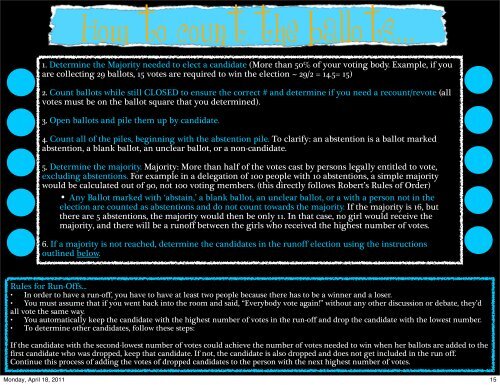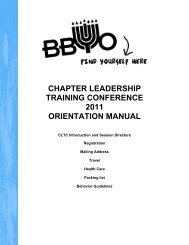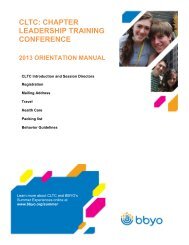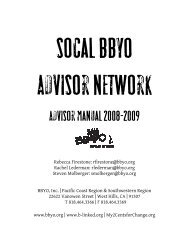N'siah Guide to Chapter Elections - BBYO
N'siah Guide to Chapter Elections - BBYO
N'siah Guide to Chapter Elections - BBYO
Create successful ePaper yourself
Turn your PDF publications into a flip-book with our unique Google optimized e-Paper software.
How <strong>to</strong> count the ballots...<br />
1. Determine the Majority needed <strong>to</strong> elect a candidate (More than 50% of your voting body. Example, if you<br />
are collecting 29 ballots, 15 votes are required <strong>to</strong> win the election ~ 29/2 = 14.5= 15)<br />
2. Count ballots while still CLOSED <strong>to</strong> ensure the correct # and determine if you need a recount/revote (all<br />
votes must be on the ballot square that you determined).<br />
3. Open ballots and pile them up by candidate.<br />
4. Count all of the piles, beginning with the abstention pile. To clarify: an abstention is a ballot marked<br />
abstention, a blank ballot, an unclear ballot, or a non-candidate.<br />
5. Determine the majority. Majority: More than half of the votes cast by persons legally entitled <strong>to</strong> vote,<br />
excluding abstentions. For example in a delegation of 100 people with 10 abstentions, a simple majority<br />
would be calculated out of 90, not 100 voting members. (this directly follows Robert’s Rules of Order)<br />
• Any Ballot marked with ‘abstain,’ a blank ballot, an unclear ballot, or a with a person not in the<br />
election are counted as abstentions and do not count <strong>to</strong>wards the majority. If the majority is 16, but<br />
there are 5 abstentions, the majority would then be only 11. In that case, no girl would receive the<br />
majority, and there will be a runoff between the girls who received the highest number of votes.<br />
6. If a majority is not reached, determine the candidates in the runoff election using the instructions<br />
outlined below.<br />
Rules for Run-Offs...<br />
• In order <strong>to</strong> have a run-off, you have <strong>to</strong> have at least two people because there has <strong>to</strong> be a winner and a loser.<br />
• You must assume that if you went back in<strong>to</strong> the room and said, “Everybody vote again!” without any other discussion or debate, they’d<br />
all vote the same way.<br />
• You au<strong>to</strong>matically keep the candidate with the highest number of votes in the run-off and drop the candidate with the lowest number.<br />
• To determine other candidates, follow these steps:<br />
If the candidate with the second-lowest number of votes could achieve the number of votes needed <strong>to</strong> win when her ballots are added <strong>to</strong> the<br />
first candidate who was dropped, keep that candidate. If not, the candidate is also dropped and does not get included in the run off.<br />
Continue this process of adding the votes of dropped candidates <strong>to</strong> the person with the next highest number of votes.<br />
Monday, April 18, 2011<br />
15
















